Jerusalem - The City of David
The original City of David, Jerusalem of ancient times, is not synonymous with the Old City. In fact, it was located on a narrow ridge south of the present-day Old City. This is the traditional site of King David's tomb. The area is also sacred to Christians because the "coenaculum" or room of the Last Supper is located nearby.
The City of David borders the Kidron Valley where the Gihon Spring, the city's water source, is located. King David understood then, as do Israel's leaders today, that control of the water supply is vital to the nation's survival.
One of David's successors, Hezekiah, King of Judah in the 8th century B.C.E., also recognized the importance of Jerusalem's water supplies. After Judah was invaded by the Assyrian king Sennacherib, Hezekiah built a tunnel to divert the city's water supply to a reservoir. The men dug the tunnel from both ends at once and met in the middle. It is possible to wade through the water still in the tunnel and follow its snaking path about a third of a mile (533 meters) under the city and exit at the Pool of Siloam.
Yemin Moshe
In 1860, British philanthropist Moses Montefiore built new housing on a hill overlooking the Old City to help relieve the congestion and poverty in the Jewish Quarter. The first of several developments was called Mishkenot Sha'ananim. Today, a unique guest house is located there, which is used by visiting writers and artists.
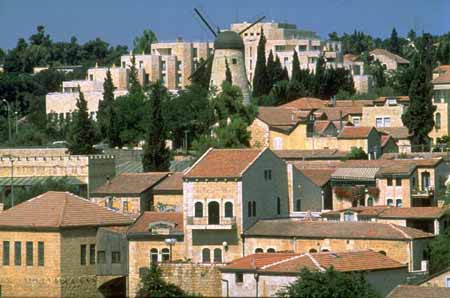 |
This area is called Yemin Moshe, and easily identifiable by the large windmill at the top of the hill overlooking the Hinnom Valley on King David Street. The windmill, was originally built to serve the milling needs of the residents of Montefiore's new developments, but it was never operational because of the lack of wind where it was situated.
A lovely (and pricey) restaurant is also located just down the stairs from the windmill, which offers a spectacular view of the Old City walls. To the left are much sought after homes in what was once an artists' colony. The popularity of the area, however, has driven prices up to the point where only one art studio remains.
A great route into the Old City is to walk down the stairs past the windmill and through the Yemin Moshe gates to the street and walk across and up the hill to Zion Gate. This takes you into the city right near the Jewish Quarter and is a relatively quick way to get to the Western Wall.
Almost directly across the street from the windmill is Liberty Bell Park, which was established in honor of America's bicentennial. A model of the Liberty Bell is inside the park. Both the original and copy are inscribed: "Proclaim liberty throughout the land unto all the inhabitants thereof" (Leviticus 25:10).
 |
Walking downhill toward downton on the same side of the street as Yemin Moshe is another beautiful park that also offers a great view of the Old City and, just beyond that, the famous King David Hotel, the most luxurious (read expensive) hotel in Israel. Along with its reputation for its accommodations, the hotel is probably best known as the target of a bomb by the Irgun, the Jewish underground organization led by Menachem Begin during the fight to gain independence from Britain. The hotel was then the British military headquarters. The bombing on July 22, 1946, killed 91 people.
Across the street from the King David is the International YMCA, one of the most beautiful Ys in the world. Its 152-foot tower is visible from much of the city and the view from the top is unparalleled. The Y also has a hotel that offers reasonable accommodations and inexpensive meals.
Mea She'arim
In 1873, Orthodox Jews founded a settlement a short distance from the Old City, just north of Jaffa Road. It was just the second neighborhood built outside the city walls, and was initially home to 100 families. The name Mea She'arim means "one hundred gates" and comes from the biblical passage, "Isaac sowed in that land and reaped in the same year a hundredfold" (Genesis 26:12).
Today, Mea She'arim is a unique neighborhood where strict interpretations of Jewish tradition rule and people dress in a manner common to Jewish ghettos of 18th and 19th century Europe. Women wear long-sleeved shirts and skirts and those who are married usually have shaved heads covered by wigs (sheitels) or scarves. The men wear long black coats and fedoras or round, fur-coveredshtreimels. Some have long white stockings and knicker-like pants, and most have tzitzit hanging below their shirts. Young boys often have very long hair (their first haircuts usually are not until they're three) and older ones long sidecurls (peyis).
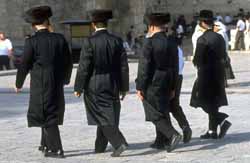 |
Mea She'arim is especially fascinating on Shabbat. People are constantly in the street, coming to or from shul. Dozens of tiny synagogues -- stiebels -- are scattered throughout the neighborhood. Men and women sit separately, usually on different floors of the bigger shuls. Go inside and you may find yourself in a world you don't recognize, where the prayers, songs and rituals are very different from those in even Orthodox synagogues elsewhere.
This is also the home of some of the more ardent guardians of Judaism, who put up barricades to prevent cars from driving by on Shabbat and protest the building of roads or archaeological excavations in areas they believe may have been Jewish burial sites.
Whatever your views on Orthodoxy, you should behave respectfully when in Mea She'arim and other religious neighborhoods. Signs are posted on buildings saying the Torah obligates women to dress appropriately. See our tips on how to dress.
Mount Scopus
Ever since the Hyatt chain built a luxury hotel on Mount Scopus, it has become a more common base from which to tour Jerusalem. Coming from downtown, however, it's quite a hike up to Scopus, so you'll probably want to go by taxi or bus. The main attraction is the spectacular panoramic view of the city, the Hebrew University and the Mount of Olives.
 The Hebrew University is one of Israel's seven universities and an excellent school that has outstanding departments in a wide range of disciplines. The university also has numerous connections to the United States, from the large number of students who spend their junior year of college studying there, to the various institutes named after or funded by Americans. To name just two, there is the The Harry S. Truman Research Institute for the Advancement of Peace and the Steven Spielberg Jewish Film Archive.
The Hebrew University is one of Israel's seven universities and an excellent school that has outstanding departments in a wide range of disciplines. The university also has numerous connections to the United States, from the large number of students who spend their junior year of college studying there, to the various institutes named after or funded by Americans. To name just two, there is the The Harry S. Truman Research Institute for the Advancement of Peace and the Steven Spielberg Jewish Film Archive.
The University opened in 1925 and was followed by the building of Hadassah Hospital in 1934. In April 1948, an Arab force ambushed a Jewish convoy on the way to Hadassah Hospital, killing 77 Jews, including doctors, nurses, patients, and the director of the hospital. Another 23 people were injured. Mount Scopus was subsequently isolated from the rest of Jerusalem by the Jordanians, and, though it remained under Israeli control, the university and hospital were both closed and relocated in West Jerusalem. After Jerusalem was retaken in 1967, they reopened.
A controversial addition to Mount Scopus was the Jerusalem Center for Near Eastern Studies built by the Mormons. A beautiful building with a stunning view of the city, it provoked a national debate because of concerns about Mormon missionary activities. The Mormons agreed not to proselytize in the city and they were subsequently allowed to create their center just down the street from the university.
The Mount of Olives
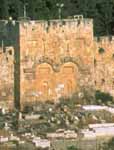 |
Visitors to the Mount of Olives stand on holy ground. Nearly 2,000 years ago, Jesusstood on this hillside overlooking the Old City making prophesies that would change the world. According to Jewish tradition, the Messiah will come through the Golden Gate (or Gate of Mercy) of the Old City and bring about the resurrection of the dead in the cemetery on the Mount.
Unlike the lush expanses of grass associated with American cemeteries like Forest Lawn or Arlington, the Mount of Olives is a mountainside of stones. One does not even see flowers adorning the markers because Jews place a small stone on the grave to indicate they have visited.
The cemetery sits atop a hill that was once dotted with olive trees. Given the sanctity of the place, the cemetery's terrible condition comes as a shock. Grave stones are broken and scattered. Most of the damage dates to the Jordanian occupation (1948-1967). On November 3 2014, three residents of the Jerusalem neighborhood of At-Tur were arrested on suspicion of smashing and breaking headstones in the Mount of Olives cemetary. The two younger suspects, aged 15 and 12, admitted to smashing dozens of headstones in the weeks prior to their arrest, while the 22 year old suspect denied involvement.
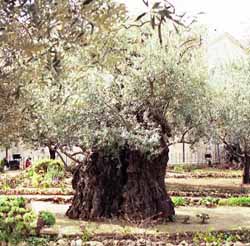 According to Christian tradition, Jesus had a prophecy that Jerusalem would be destroyed and went down to the Mount of Olives with his followers on Palm Sunday. He then wandered around the city for about a week and taught his disciples in caves on the Mount of Olives.
According to Christian tradition, Jesus had a prophecy that Jerusalem would be destroyed and went down to the Mount of Olives with his followers on Palm Sunday. He then wandered around the city for about a week and taught his disciples in caves on the Mount of Olives.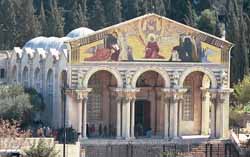 On Thursday, the Jewish holiday of Passover, Jesus went to a building on Mount Zion (near where Dormition Abbey now stands at the southeast corner of the Old City) and ate the Last Supper. He and two disciples then left Jerusalem and went to Gethsemane and sat among the olive trees. The grove, at the base of the Mount, is maintained as it was nearly 2,000 years ago. The olive grove is within the walls of the Basilica of the Agony, which stands on the spot where Jesus prayed prior to his arrest. It is located on Jericho Road facing the Golden Gate.
On Thursday, the Jewish holiday of Passover, Jesus went to a building on Mount Zion (near where Dormition Abbey now stands at the southeast corner of the Old City) and ate the Last Supper. He and two disciples then left Jerusalem and went to Gethsemane and sat among the olive trees. The grove, at the base of the Mount, is maintained as it was nearly 2,000 years ago. The olive grove is within the walls of the Basilica of the Agony, which stands on the spot where Jesus prayed prior to his arrest. It is located on Jericho Road facing the Golden Gate.Israel Fact
The olives of the oldest olive tree in the Garden of Gethsemane (derived from the Aramaic for "oil press"), where Jesus was arrested by the Romans, were flown to the Vatican for Pope John Paul II.
|
Inside the Basilica, pilgrims try to empathize with the suffering of Jesus. The church itself is spartan by European standards, though it has impressive murals depicting the events that took place in Gethsemane. A sculpture of thorns surrounds the spot in the middle of the church where Jesus prayed. A beautiful colored mosaic over the entrance depicts the acceptance of Jesus by the world.
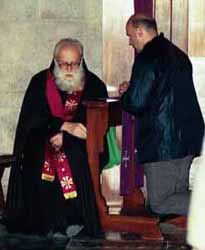 After Jesus was arrested, he was taken a short distance up the hill to where Dominus Flevit ("The Lord Wept") now stands. It is beside the cemetery with a narrow road in between. The grounds also contain a cave where Jerusalemites buried their dead centuries ago. Families put the bodies of loved ones in sarcophagi. Some time later, after the flesh had rotted, the bones were removed and put In small boxes on shelves in caves. Some of these boxes are still in the cave. What is particularly significant about them is that Christian symbols were found carved on the tombs of people with Jewish names. These are the oldest remains of Jews who became the first converts to Christianity.
After Jesus was arrested, he was taken a short distance up the hill to where Dominus Flevit ("The Lord Wept") now stands. It is beside the cemetery with a narrow road in between. The grounds also contain a cave where Jerusalemites buried their dead centuries ago. Families put the bodies of loved ones in sarcophagi. Some time later, after the flesh had rotted, the bones were removed and put In small boxes on shelves in caves. Some of these boxes are still in the cave. What is particularly significant about them is that Christian symbols were found carved on the tombs of people with Jewish names. These are the oldest remains of Jews who became the first converts to Christianity.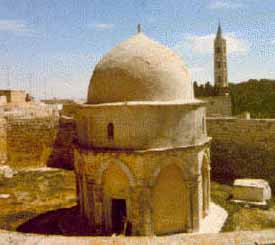 According to Christian tradition, after the crucifixion Jesus wandered 40 days on the Mount of Olives and ascended to heaven from a point on the hill. A small shrine inside the walls of the Greek Patriarchate contains stone stumps with crosses carved on the tops that mark the spot where the disciples watched the ascension.
According to Christian tradition, after the crucifixion Jesus wandered 40 days on the Mount of Olives and ascended to heaven from a point on the hill. A small shrine inside the walls of the Greek Patriarchate contains stone stumps with crosses carved on the tops that mark the spot where the disciples watched the ascension.
Ironically, the Chapel of the Ascension is now run by the Muslims, who built a dome over the rock from which Jesus ascended to the heavens and upon which his footprint can be seen. The Chapel is off the Mount of Olives Road, just above the cemetery as you travel from Mount Scopus. Further down the road is the Tower of the Ascension, today a small Russian Orthodox Church, where Mary watched Jesus ascend to heaven.
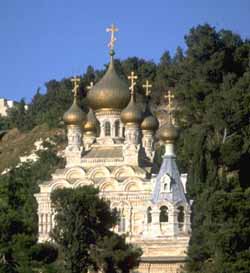 |
Though it has no particular historical significance, the most impressive looking church in Jerusalem is probably the Church of Mary Magdalene. This is the building that looks like all the pictures you see of the Kremlin with golden onion domes rising from the trees.
From the Mount of Olives, you can also see the conical-roofed Absalom's Tomb and the pyramid-roofed Zechariah's Tomb. These are tombs of anonymous second century citizens of Jerusalem and have nothing to do with their biblical namesakes.
Ammunition Hill
 Prior to the Six-Day War, Ammunition Hill was Jordan's most heavily fortified stronghold in divided Jerusalem. Its central bunker served as a command post, mess hall and storage area for weapons and other war materiel. A maze of trenches and pillboxes on the hill were connected with the bunker. The battle for Ammunition Hill was fierce and cost the lives of 24 Israeli paratroopers. As a result of the victory, Israeli forces could open the road to Mt. Scopus and the fall of the Old City was greatly facilitated. These two achievements were crucial to the reunification of the city. Today, a memorial and museum are on the site.
Prior to the Six-Day War, Ammunition Hill was Jordan's most heavily fortified stronghold in divided Jerusalem. Its central bunker served as a command post, mess hall and storage area for weapons and other war materiel. A maze of trenches and pillboxes on the hill were connected with the bunker. The battle for Ammunition Hill was fierce and cost the lives of 24 Israeli paratroopers. As a result of the victory, Israeli forces could open the road to Mt. Scopus and the fall of the Old City was greatly facilitated. These two achievements were crucial to the reunification of the city. Today, a memorial and museum are on the site.Ma’ale Adumim
Ma’ale Adumim is a suburb of Israel’s capital, barely three miles outside Jerusalem’s city limits, a ten-minute drive away. It was established by 23 families on a hilltop in 1975. Today, it is the largest Jewish city in the West Bank, with a population of 27,300. Approximately 6,000 people live in surrounding settlements that are included in what is referred to as the Ma’ale bloc. These communities are part of the “consensus” settlements; that is, those that most Israelis expect to be incorporated into Israel when its final borders are determined.
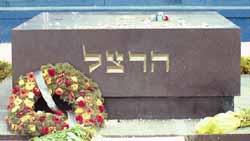 As you head out of the center of town, up the hill on Herzl Street you'll reach the memorial park and cemetery dedicated to the founder of political Zionism,Theodor Herzl, whose tomb is at the summit of the mountain.
As you head out of the center of town, up the hill on Herzl Street you'll reach the memorial park and cemetery dedicated to the founder of political Zionism,Theodor Herzl, whose tomb is at the summit of the mountain.
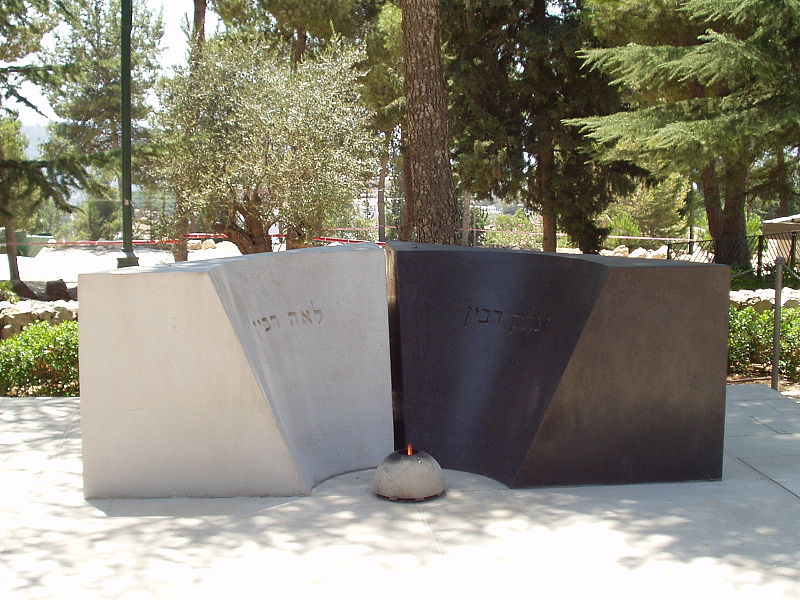 Along with Herzl, many of Israel's other leaders, such as former Prime Ministers Golda Meir and Levi Eshkol, are buried in the cemetery. Since histragic murder in 1995, Yitzhak Rabin's grave has also become a magnet for tourists.
Along with Herzl, many of Israel's other leaders, such as former Prime Ministers Golda Meir and Levi Eshkol, are buried in the cemetery. Since histragic murder in 1995, Yitzhak Rabin's grave has also become a magnet for tourists.
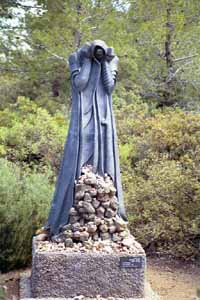 The Historical and Art Museums, as well as the Hall of Remembrance, the Valley of the Communities, the Children's Memorial, and other monuments attest to the tragic events that befell the Jewish people and instruct visitors to Yad Vashem on the uniqueness of the Holocaust and its universal lessons. The Hall of Names is part of an effort to collect the names of every Jewish man, woman and child murdered in the Shoah.
The Historical and Art Museums, as well as the Hall of Remembrance, the Valley of the Communities, the Children's Memorial, and other monuments attest to the tragic events that befell the Jewish people and instruct visitors to Yad Vashem on the uniqueness of the Holocaust and its universal lessons. The Hall of Names is part of an effort to collect the names of every Jewish man, woman and child murdered in the Shoah.
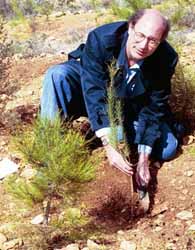 Some of the most impressive sites in Israel are natural ones. In Jerusalem and its outskirts are some magnificent forests. The Jerusalem Forest is not far from Mount Herzl and is an excellent place to physically contribute to the greening of Israel by planting your own tree.
Some of the most impressive sites in Israel are natural ones. In Jerusalem and its outskirts are some magnificent forests. The Jerusalem Forest is not far from Mount Herzl and is an excellent place to physically contribute to the greening of Israel by planting your own tree.
The heart of the city is located around King George Street, Jaffa Road and Ben-Yehuda Street. This is where you'll find a bustling pedestrian mall filled with people from all over the world, restaurants, souvenir shops and street musicians and artists. It is also where you can find some of the imports from America, such as McDonald's.
If you want a more "sophisticated" evening out, go for tea at theKing David Hotel. To see where the foreign journalists congregate, go to the American Colony Hotel in East Jerusalem.
 |
Jaffa Road leads into the Old City. If you head in the opposite direction, you'll pass Mahane Yehuda, the outdoor market where you'll find all sorts of fish, meat, vegetables, fruit and odds and ends. On Friday, the place is really hopping as people stock up on supplies for Shabbat.
Up King George Street toward Yemin Moshe, you'll see the impressiveGreat Synagogue just across from Independence Park and the Sheraton Hotel. Hechal Shlomo, adjoining the synagogue, is the former headquarters of the Sephardi andAshkenazi Chief Rabbis.
The Israel Museum
 |
Jerusalem is a wonderful city to explore on foot, but it is a large and hilly place and a few of the more interesting and important sites are not really within walking distance of the hotels where most visitors stay. They are easily accessible, however, by bus or taxi.
One of the premier "modern" attractions in Jerusalem is the Israel Museum where the fragments of the Dead Sea Scrolls are exhibited in a special building known as the Shrine of the Book. The distinctive white, domed-shaped ceiling of the building is modeled after the clay jars in which the scrolls were found. The scrolls are the oldest manuscripts of the Old Testament ever found.
The Museum also has a wonderful sculpture garden with masterpieces by Rodin, Henry Moore and others, galleries with works by modern and classical artists, including Rembrandt, Chagall, Picasso and Miró, and archaeological relics dating as far back as the Early Stone Age. The Museum is also known for having perhaps the world's finest collection of Judaica.
The Knesset
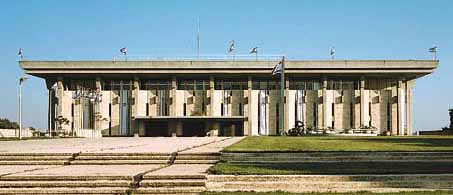 |
Not far from the Israel Museum are many of the Israeli government ministries and the Knesset, Israel's parliament. The Knesset took its name and fixed its membership at 120 from the Knesset Hagedolah (Great Assembly), the representative Jewish council convened in Jerusalem by Ezra and Nehemiah in the 5th century B.C.E.
When visiting the Knesset and other government offices, be sure to bring a passport. Security is tight and the lines to pass through the gates are sometimes long. Once inside the building, the highlight of the tour is the State Hall where three tapestries and a mosaic created by Marc Chagall decorate the walls and 12 mosaics cover the floor.
Just as most visitors to the U.S. Capitol are surprised when they find few, if any, members of Congress in the chambers most of the time, it is likely the Knesset will also be empty, or nearly so, unless a major issue is being debated while you are there. Unlike Congress, debates in the Knessetare free-wheeling, with frequent shouting and finger pointing. Like the British Parliament, the opposition also heckles the Prime Minister and other government officials.
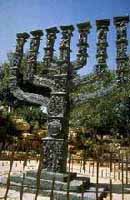 |
Across from the entrance to the Knesset is the impressive bronze menorah given to Israel as a gift from the British government in 1956. It depicts events in Jewish history from the time of Moses to modern times. The inscription, from theprophet Zecharia, reads: “Not by might nor by power but by my Spirit says the Lord of Hosts.”
Also nearby are the new Israeli Supreme Court buildings, which have been acclaimed for their contemporary architecture.
The area around the Knesset and Supreme Court also has a beautiful garden, Gan Havradim, which is filled with roses from around the world.
Mount Herzl Cemetery
 As you head out of the center of town, up the hill on Herzl Street you'll reach the memorial park and cemetery dedicated to the founder of political Zionism,Theodor Herzl, whose tomb is at the summit of the mountain.
As you head out of the center of town, up the hill on Herzl Street you'll reach the memorial park and cemetery dedicated to the founder of political Zionism,Theodor Herzl, whose tomb is at the summit of the mountain. Along with Herzl, many of Israel's other leaders, such as former Prime Ministers Golda Meir and Levi Eshkol, are buried in the cemetery. Since histragic murder in 1995, Yitzhak Rabin's grave has also become a magnet for tourists.
Along with Herzl, many of Israel's other leaders, such as former Prime Ministers Golda Meir and Levi Eshkol, are buried in the cemetery. Since histragic murder in 1995, Yitzhak Rabin's grave has also become a magnet for tourists.
Israel's principal military cemetery — its Arlington — is also located here. If you've never been to a Jewish cemetery, you'll notice flowers are not placed at the graves; instead, it is traditional for visitors to place small stones on the tombstones.
Hadassah Hospital
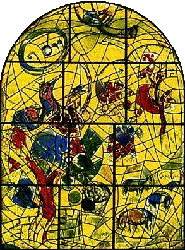 |
One of the world's premier hospitals is about ten minutes further up the road inEin Kerem. Besides being an internationally renowned medical facility and research institution, Hadassah Hospital is known for the spectacular stained glass windows of its synagogue. The 12 windows created by Marc Chagall represent the sons of Jacob from whom came the tribes of Israel. The hospital, founded by the women's Zionist organization, was originally built on Mt. Scopus. When that area was lost in the 1948 war, the modern hospital was built here in 1962.
Yad Vashem Holocaust Museum
A little beyond Mt. Herzl is the Israeli Holocaust museum. Yad Vashem was established by Israeli Law in 1953 to commemorate the six million Jews and their communities wiped out in the Holocaust. It has the largest and the most comprehensive archive and information repositories on the Holocaust, housing more than 50 million pages of documents and hundreds of thousands of photographs and films.
A dream I dreamt of terrible woe,
My people gone, alive no more. I arose with a shout: "Oh no!, Oh no!" The dream I dreamt -- It has become so! "O God on high," shuddering, I cry, "My people, dead! Wherefore and why? Wherefore and why? In vain they died, Not in war, fighting for their lives, The young, the old, even wife and child, They are no more -- lament the sorrow! All day, all night, I weep and cry, Wherefore, O God? Why, Adonai?"
--Yitzchak Katznelson
|
 The Historical and Art Museums, as well as the Hall of Remembrance, the Valley of the Communities, the Children's Memorial, and other monuments attest to the tragic events that befell the Jewish people and instruct visitors to Yad Vashem on the uniqueness of the Holocaust and its universal lessons. The Hall of Names is part of an effort to collect the names of every Jewish man, woman and child murdered in the Shoah.
The Historical and Art Museums, as well as the Hall of Remembrance, the Valley of the Communities, the Children's Memorial, and other monuments attest to the tragic events that befell the Jewish people and instruct visitors to Yad Vashem on the uniqueness of the Holocaust and its universal lessons. The Hall of Names is part of an effort to collect the names of every Jewish man, woman and child murdered in the Shoah.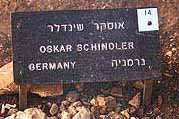 |
Yad Vashem also pays tribute to the courageous non-Jews, such as Oskar Schindler and Raoul Wallenberg, who risked their lives to save Jews from certain death. These rescuers are awarded the title of Righteous Among the Nations and given a certificate and a medal with the Talmudic inscription “Whoever saves a single soul, it is as if he had saved the entire world.” A tree is then planted on the walkway, marked by a plaque bearing the name and nationality of the Righteous Person.
The Jerusalem Forest
 Some of the most impressive sites in Israel are natural ones. In Jerusalem and its outskirts are some magnificent forests. The Jerusalem Forest is not far from Mount Herzl and is an excellent place to physically contribute to the greening of Israel by planting your own tree.
Some of the most impressive sites in Israel are natural ones. In Jerusalem and its outskirts are some magnificent forests. The Jerusalem Forest is not far from Mount Herzl and is an excellent place to physically contribute to the greening of Israel by planting your own tree.Israel Fact
Americans are honored throughout Israel. For example, in Tel Aviv, Abraham Lincoln and Woodrow Wilson have streets named after them. George Washington Street is in Jerusalem and Martin Luther King has a street and memorial in his honor in the Galilee. A statue of Lincoln is in Ramat Gan and a replica of the Liberty Bell was built in Jerusalem's Liberty Bell Garden.
|
This forest is also home to a special memorial to President Kennedy. The building resembles the stump of a tree that was chopped down in its prime. It consists of 51 columns in a circle, representing the 50 states and the District of Columbia. Inside, an eternal flame burns in front of a bust of JFK. The surrounding trees were also planted in the President's honor.
Even this lengthy description of Jerusalem does not do justice to all there is to see and do. Get off the tour and immerse yourself in the city. Until you return, you will never be in a place like this again.
Jerusalem
Driving up the main road from the airport or Tel Aviv into the mountains, Jerusalem welcomes you with an inspiring blend of old and new. In 2008, the city unveiled the new "Jerusalem Chords Bridge" - a high tech lightrail bridge ove the city entrance that is built to the style and shape of a harp, the famous musical instrument of Israel's great King David. Designed to add a defining visual element to the city skyline, much like San Francisco's Golden Gate Bridge, the Empire State Building in Manhattan or the Champs-Elysées of Paris, the Chords Bridge blends the biblical history of Jerusalem with its modern flare.
The entrance to Jerusalem is still pretty abrupt, though; one minute you're on the highway and the next you've been transported to a different world. Almost immediately you find yourself on narrow streets with low-level buildings, many dating back decades and some even containing holes from where bullets struck them during various wars. The sidewalks are typically filled with people scurrying about, ultra-orthodox Jews or hasidim in their distinctive garb, university and high school students, soldiers with automatic rifles casually slung over one shoulder with a knapsack over the other. The unparalleled mixture of the ancient and modern, the secular and religious is apparent at once. You feel that something is different and, intellectually and spiritually, you know this is a place unlike any other.
One of its many unique qualities is that Jerusalem almost completely shuts down on Shabbat. This is a time of incredible quiet, like nothing you can experience in any other major city, when the observant Jews head for the Western Wall, synagogues and family gatherings, and less observant Jews enjoy their one day off from work, spend the day with their families, relax and take in the breathtaking beauty of the city. A handful of restaurants stay open and people still roam the streets, but most activity ends mid-day Friday and doesn't pick up again until after dark on Saturday.
Jerusalem is the largest city in Israel and the nation's capital. It is a place where you can have fun, but it is more spiritual than spirited. Of course, sometimes the spirit moves people a little too far. In fact, psychologists have identified something they call the "Jerusalem syndrome" to describe people who become so intoxicated with the city they act irrationally, sometimes to the point of believing themselves to be the messiah.
For purposes of this tour, we’ve divided the city into four sections. The first offers an overview of the city's long and rich history. This includes a discussion of the current controversy over the future of the city.
The next stop is the Old City, roughly 220 acres surrounded by walls built by Suleiman the Magnificent in the 16th century. This is the heart of the city and has both political and religious significance. The Old City is divided into quarters — Jewish, Armenian, Muslim and Christian. The holiest place for Jews is the Western Wall in the Jewish Quarter. Two of Islam’s most important shrines, the Dome of the Rock and al-Aksa Mosque are in the Muslim Quarter on theTemple Mount. The Church of the Holy Sepulcher in the Christian Quarter is revered by Christians as the site of the death, burial, and resurrection of Jesus Christ. Here you can imagine life centuries ago and even walk on original 2,000-year-old stones.
The neighborhoods beyond the Old City walls include Yemin Moshe, the first Jewish neighborhood built outside the walls, which is identifiable by its distinctive – and unusable – windmill; Mount Scopus, home of the Hebrew University; the Mount of Olives, the site of several important Christian shrines and the cemetery where Jews have buried their dead for centuries andMea She’arim, an island in time where ultra-Orthodox Jews dress and behave in traditional ways and strictly observe Jewish law.
The "new" city is the more modern part of Jerusalem that was mostly built after Jordan occupied the Old City and the rest of the eastern half of the city following the 1948 war. This is where Israel has established most of its government offices, including the Knesset and the magnificent new Supreme Court building. It is also where you can find the world-renowned Hadassah Hospital, with its famous Chagall windows; Mt. Herzl, the final resting place of most of Israel’s leaders andYad Vashem, Israel museum and memorial to the Holocaust. Most visitors stay in this part of the city, which also has beautiful parks and a lively downtown with clubs, shops and restaurants.
For believers, this is the place where the call to God is a local one. For everyone else, it is a place of great beauty and history that is unlike anywhere else on earth.
Travel Preparation
The Road to Jerusalem
Ben-Gurion Airport is located in the town of Lod (also known by its Greek name, Lydda), an ancient city dating to the time of the Canaanites. It was an exclusively Jewish town at the time of the Maccabees, but the inhabitants were all sold into slavery in 43 B.C.E. Much later, it became a home of the Crusaders. The remains of the 12th century church they built is now part of the Greek Orthodox Church of St. George.
 |
When you leave Ben-Gurion Airport and head out on the road toJerusalem, hopefully the adrenalin rush of finally reaching Israel will help you overcome jet lag. Tempting as it may be to sleep, you don't want to miss the scenery along the road.
One of the things that might strike you here and elsewhere in the country is how sparsely populated it is. Reading the newspaper and watching the news often gives the impression that the country is overflowing with people, but, even with a population of more than six million now, there's plenty of room for growth.
Besides some beautiful scenery as you approach Jerusalem, you might notice some monuments along the road and old, rusted military vehicles. These are reminders of the battles that took place along the Tel-Aviv-Jerusalem corridor during Israel's fight for independence in 1948. Before the Arab states invaded on May 15, irregular forces were blockading the route, making it difficult and, at times, impossible to bring supplies to the Jews living in Jerusalem.
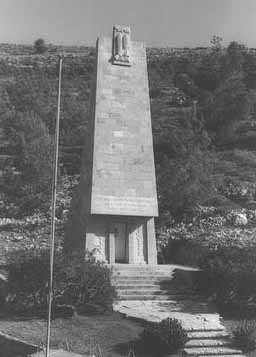 Memorial at Kiryat Anavim to the fallen of Harel Palmach Brigade, who opened the road to Jerusalem (GPO Photo) |
The Israeli paramilitary forces that preceded the founding of the Israel Defense Forces, the Haganah, Irgun and Lehi, battled Arab villagers and soldiers who infiltrated across the porous borders of Palestine after the United Nations partition decision to create a Jewish and an Arab state in Palestine. While the Jews accepted the decision, the Arabs did not, and almost immediately launched violent attacks to prevent the UN decision from being implemented.
It became vital for the Jewish forces to capture some of these Arab towns to keep the road open. On April 9, during one such battle, a combined force of Lehi and Irgun fighters attacked the village of Deir Yassin in one of the most notorious and misrepresented confrontations in the history of the Arab-Israeli conflict.
After the Arab invasion and the war began in earnest, the situation inJerusalem became even more bleak. An American soldier then played a key role in the battle for the roads. Michael Stone, better known asMickey Marcus, was the one who decided it was necessary to construct the "Burma Road" (named for the road paved by the Allies from Burma to China during World War II), a make-shift winding path through the seemingly unpassable mountains around Jerusalem that bypassed the main road. This allowed the Jewish forces to relieve the Arab siege on June 9, just days before the United Nations negotiated a cease-fire. Had the convoys not gotten through, the Jews remaining in Jerusalem would have starved or been forced to surrender. For this courageous act and other contributions to the defense of Israel, David Ben-Gurion named Marcus a general, making him the first general in the army of Israel in nearly two thousand years (for a Hollywood version of the story, rent Cast a Giant Shadow, starring Kirk Douglas as Marcus and co-starring John Wayne, Frank Sinatra and Yul Brynner).
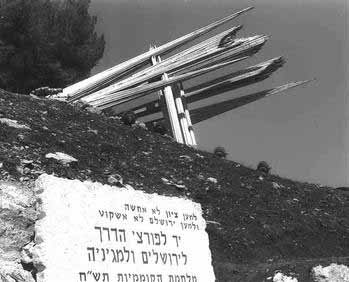 Memorial for those who fell in the battles for the road to Jerusalem (GPO Photo) |
The road provided relief to the beleaguered Jews in Jerusalem for nearly five months, until December 1948, when the road connecting the Nachshon and Shimshon Junctions was opened. The road has been restored and is now marked with signs indicating places of historic significance.
The road that is now the principal artery between Tel Aviv andJerusalem was completed around the time that Anwar Sadat made his momentous visit to Israel, which paved the way [forgive the pun] for the peace treaty with Egypt. The road was not yet open to the public, but was used to transport Sadat for security reasons.
Latrun
Along the road to Jerusalem, near the junction to the main artery south, is Latrun, the site of many famous military battles. Here, Joshua commanded the sun to stand still and the Maccabees, Romans, Crusaders, Arabs and British marched through here on the way to Jerusalem. In Israel's War for Independence, some of the fiercest fighting of the war took place at Latrun. From 1948 to 1967, the Israelis were unable to gain control of the road and had to build a detour to circumvent the Arab legion. Known as no-man’s land, the UN had to supervise this area of land, until it was retaken by Israel in 1967.Anyone who ever liked playing with soldiers and tanks as a kid, or still finds military hardware and strategy of interest, will love the Museum of the Israel Defense Forces Armored Division. The museum has a memorial to the brigade that fought here and more than 100 tanks used in Israel’s wars are displayed. You can climb on some of the earliest tanks made and compare them to ultra-modern versions built by Israel’s own military-industrial complex and those imported from the United States.
 Latrun Tank Museum |
Ideal especially for younger kids is nearby Mini Israel, a park where you can tour a miniaturized version of the major landmarks in Israel.The Latrun Monastery, which was founded in 1890 by a group of Trappist monks from France, is across from the tank museum. Damaged in World War I, the monastery was restored and rebuilt in 1927. The monks have taken a vow of silence, but those selling wine grown from the local vineyards to tourists are given a special dispensation to speak.Another interesting site is the remains of a 12th century Crusader fortress, Le Toron des Chevaliers. Saladin wrecked the fortress on his march to stop Richard the Lion-Heart from advancing into Jerusalem. Next to the Crusader fort is an abandoned British police station, which was held by the Arabs in the 1948 war and later used by the Jordanians.Roughly half-way between Jerusalem and Tel Aviv is the Neot Kedumim Biblical Landscape Reserve. With more than 600 acres, this beautiful expanse is a living museum in which every plant mentioned in the Bible and Talmud can be found growing. Trails devoted to different sections of the Bible — The Forest of Milk and Honey, the Dale of the Song of Songs, Isaiah's Vineyard — are designed to bring the ancient texts to life.
Castel
The site of a key battle in the 1948 war is Castel, which is atop a mountain 2,600 feet high along the road to Jerusalem, about 6 miles outside the city. The city is named for a fortress built in Roman times. During the mandate period, an Arab village occupied this strategic high ground and the Haganah decided in early 1948 it was necessary to take the hilltop to keep open the road to Jerusalem. After a fierce battle, the village was conquered on April 9. Today, the site has a model of the battles.
Bet Shemesh
Just off the Tel Aviv-Jerusalem highway is Bet Shemesh, a historic town that dates back to the third century B.C.E. The city is mentioned numerous times in the Bible, includingI Samuel 5, when it is the site of the recovery of the Ark of the Covenant from thePhilistines. Recent archeological findings indicate that settlement continued throughout the Temple and Roman periods. The modern town was originally founded as a farm byBulgarian immigrants in 1895, and was later the scene of heavy fighting during the War of Independence. Today, the primarily Orthodox town is home to some 21,000 inhabitants, many of them immigrants from North America and England
Travel Preparation
Are you ready to go to Israel?
Let's check.
Here we will discuss some of the information you might want to have before you leave for a visit to Israel as well as some suggestions about what to bring and how to prepare for the experience of a lifetime.
Packing Checklist
How much you pack depends partially on how long you stay. In Israel, you'll probably be moving around a lot and you won't want to pack and unpack a lot of stuff. Generally, it's a good idea to travel light and expect that you will need more room in your bags when you go home than when you left to accommodate gifts, dirty clothes and the tendency for clothes to take up more space on the return flight. Also, remember that the power supply is 220 volt AC-50 cycles. Make sure your electrical items can operate or purchase an adaptor kit (hotels sometimes can spare them).
| Airplane Tickets | Travelers Checks | Passport |
| Wallet/Handbag | Itinerary | Cash |
| Credit Card | First Aid supplies | Camera |
| Phone Numbers | Safety pins | Comb/Brush |
| Watch | Sunscreen | Plastic bags |
| Deodorant | Sun Glasses | Soap |
| Prescriptions | Bathing suit | Tooth brush/paste |
| Aspirin | Sweater/Sweatshirt | Hat |
| Raincoat (winter) | Shirts | Pajamas |
| Pants | Walking shoes/hiking boots | Handkerchiefs/scarves |
| Dress shoes | Belt(s) | Socks |
| Underwear | Backpack | Slippers/Sandals |
| Dresses |
Time
Israel is seven hours ahead of Eastern Standard Time, eight hours ahead of Central Time, nine hours ahead of Mountain Time and ten hours ahead of Pacific Time. It is two hours ahead of Greenwich Mean Time.
Dress & Manners
You can't generalize anymore about Israelis than any other people. You'll find good and bad. As a visitor, you should always be courteous, even if you encounter a native who is not.
Unless you specifically go to Arab neighborhoods, most Arabs you meet will probably be working in Israeli hotels or merchants. If you do go to Arab towns in Israel or the territories, you will find they are typically very hospitable and likely to invite you into their homes for tea and a bite to eat. Some may be comfortable talking about politics, others may not. Be a good guest.
Dress in Israel is casual. Even Israeli prime ministers frequently wear short-sleeve shirts without ties. You'll notice the checklist has a variety of apparel. You'll need warm clothes during winter months. If you plan to go to religious shrines or services, you should bring nice clothes. Jewish holy places usually allow you to enter with shorts, but the shrines of other faiths often require more modest dress. This is true also in religious Jewish neighborhoods where women, especially, are expected to wear sleeves below the elbow and skirts below the knees. One alternative is to carry a shawl that you can wrap around your shoulders or bare legs, or a wrap skirt to cover your shorts. Regardless of your personal views, respect those of the people who live there and you will have no trouble.
Weather
Israel enjoys long, warm, dry summers (April-October) and generally mild winters (November-March), with somewhat drier, cooler weather in hilly regions, such as Jerusalem and Safed. Rainfall is relatively heavy in the north and center of the country with much less in the northern Negev and almost negligible amounts in the southern areas. Regional conditions vary considerably, with humid summers and mild winters on the coast; dry summers and moderately cold winters in the hill regions; hot dry summers and pleasant winters in the Jordan Valley and year-round semi-desert conditions in the Negev.
Food
Israel has great food. Most people are probably familiar with falafel -- fried ground chick peas served with salad in pita. Meat eaters will love shwarma, lamb sliced off a spit and served in pita (similar to gyros). Both are cheap, filling meals. Lots of other Mediterranean specialties like shishlik (shish kebab), baklawa (sweetmeat made of dough, honey, and nuts) and moussaka (baked eggplant, minced meat, onion and parsley) will stimulate your taste buds. The Americanization of Israel also means you'll find such familiar names as McDonald's, Burger King, Pizza Hut and Dunkin' Donuts.
The water in Israel is safe to drink; nevertheless, it is different from what you are used to and people with sensitive stomachs may want to stick to bottled water. Also, Israelis don't usually put ice in their drinks, so if you want some, ask for kerakh.
Keep in mind that not everything in Israel is kosher. Restaurants that are kosher serve either dairy or meat and close on Shabbat. The restaurant should have a Teudatcertificate either in the window or available for inspection. Unless the menu or check says otherwise, tips are not included.
Safety
Forget what you've read in the papers or seen on TV; Israel is a very safe place to visit. You are far more likely to run into trouble in any major U.S. city than anywhere in Israel. Behave in Israel the way you would in those cities. Be careful where you go at night and travel in groups when possible. Generally, it is safe in most places in Israel to walk alone at night. The territories are a different story. It is advisable only to go into Gaza or the West Bank in a group and with an Israeli guide.
One of the first things you'll notice when you arrive in Israel is the number of people carrying guns. It can be disconcerting. Soldiers carry them on the streets, in cars and on buses. Soldiers are required to keep their weapons with them, and since so many Israelis are on duty, it is common to stand next to someone on the bus with an Uzi hanging around their neck. You'll quickly get used to it and realize it's a fact of life in Israel and nothing to fear.
In an emergency, dial 101.
Useful Hebrew Words
Whenever you go to a foreign country, it is a good idea to familiarize yourself with the local language and customs. Most people in Israel speak English, but, with the influx of Jews from the former Soviet Union, you're almost as likely to run into someone who speaks just Russian as Hebrew. Even if you aren't fluent in the language, natives usually appreciate it when visitors make an effort to speak in their native tongue. Below are a few common Hebrew phrases that will help you get by in Israel. If you don't learn anything else, memorize "Please," "Thank you" and "You're welcome."
| hello | sha-LOM |
| goodbye | sha-LOM |
| good morning | BO-ker TOV |
| good evening | erev TOV |
| goodnight | lie-lah TOV |
| see you later | le-HIT-rah-OTT |
| thank you | to-DAH |
| please | be-va-ka-SHA |
| you're welcome | be-va-ka-SHA (lo-davar) |
| I don't speak Hebrew | AH-NEE lo m'dah-BEHR ee-VREET |
| Do you speak English? | at-TAH m'dah-BEHR ang-LEET? |
| money | KES-sef |
| yes | ken |
| no | loh |
| excuse me | slee-CHA |
| where is | AY-fo |
| bus | o-to-bus |
| taxi | ta-ksi (mo-nit) |
| market | shuk |
| How much does it cost? | kama zeh o-leh? |
| Where's the bathroom? | Ay-fo ha sher-u-teem? |
| doctor | ro-feh |
| hospital | bet kho-lim |
| police | mish-ta-rah |
| breakfast | a-ru-chat bo-ker |
| lunch | a-ru-chat tzo-ho-ra-yim |
| dinner | a-ru-chat erev |
| water | ma-yim |
Getting Around
Since most Israeli cities are small, you can walk most places you need to go. You'll see a lot and have more opportunities to interact with the people. If you're on your own, get a map from a hotel or tourist office and you'll be in good shape.
You can rent a car, but driving in Israel is not for the faint of heart. The roads are probably the most dangerous places in Israel and the traffic, especially in and around Jerusalem and Tel Aviv, is terrible.
Taxis are a common mode of transportation, but, as in most places, drivers are not always honest. They will frequently try to take you for a ride without using their meter. NEVER let them do this. Always ask before you get in the cab how much the fare should be and insist they use a meter. The one exception is for long trips, such as between Tel Aviv and Jerusalem (and from the airport) where the fares are usually set before you leave. For those longer trips, it is usually more inexpensive, though less comfortable and convenient, to take a group taxi or sherut. You can also learn a lot about Israel by talking to cab drivers; they're usually not shy about offering their opinions. You do not have to tip cab drivers.
The most popular mode of travel is the bus. Busses are inexpensive and the newer ones are very comfortable. Don't be afraid to ask the driver or other passengers for help in identifying your stop. Because of the long distance, some people choose to fly to Eilat (under $200 in early 2000), but it's usually part of the itinerary on student trips traveling by bus.
You can make overland crossings into Egypt at Rafiah, about 30 miles southwest of Ashkelon, and Taba, the last town Israel returned to Egypt as part of the peace treaty, which is just south of Eilat. Buses run between Cairo and Tel Aviv and Jerusalem. It is also possible to take a series of taxis. The trip is a long one through the desert, broken up by a short boat ride across the Suez Canal, that you are unlikely to forget.
It is also possible to visit Jordan by crossing the Allenby Bridge near Jericho (about 25 miles from Jerusalem), going via the Arava Terminal in Aqaba near Eilat or taking the northern route through the Jordan River Terminal just north of Bet She'an.
Accommodations
Even if you're on a tour, you may have some free days to tour and you'll need a place to stay. Israelis are wonderfully accommodating and if you have long-lost relatives, they're more than likely to be excited to meet you and offer you a bed.
If you don't have friends or family in Israel, it is usually possible to find people who will take you in, particularly for Shabbat. This is one of the best ways to really get to know Israelis.
Some yeshivas will also let people stay in their dorms. Keep in mind that you are allowed to visit in the hope you'll decide to spend a prolonged period studying there, but usually there's no requirement that you attend classes. Of course, you might find the opportunity to study with some of the world's leading scholars rewarding.
Israel has youth hostels that are inexpensive and part of the international hostel system.
Many kibbutzim also have guest houses. Though less luxurious than hotels, don't expect them to be cheap.
Israel has camp grounds as well in many of the beautiful parks around the country and in the desert.
Shopping
Israel is a good place to buy souvenirs. As in other Middle Eastern countries, haggling in Israel is a tradition. Keep the following points in mind when you're shopping:
- It is rare that you should ever have to pay the full price listed on an item (note this applies mostly to souvenirs, not everything in the markets and is not true of ordinary retail shops like department stores).
- Always be ready to walk out of a shop and don't be surprised if the sales person follows you out.
- Don't think you'll get any better deal from Jews than Arabs. Sometimes the opposite is true.
- The merchants in the market in the Old City, in particular, can be very aggressive. Don't be intimidated. Remember, you're the customer and it is their job to satisfy you.
- Keep in mind what you can afford and don't let yourself be talked into paying more. You'll probably see the same items in more than one store, so shop around before you decide.
- Be clear on the exchange rate before you buy.
- Haggling is an art, and involves some gamesmanship, but it isn't polite to waste a merchant's time if you have no intention of buying something.
Items common in the U.S., such as film and books are likely to be more expensive in Israel than at home. By paying with a credit card, you can usually get a better exchange rate. Sometimes you can get a better price if you pay with U.S. dollars.
Also, Israel assesses a Value Added Tax (VAT) of 17% on goods and services. Prices should include this tax. For purchases over $50, you can get a refund of the tax at the airport before you leave. To do so you'll want to get to the airport early so you can go to the customs office. When you make your purchase, the merchant should put it in a clear plastic bag with a copy of the receipt inside. Keep the original. The bag must be sealed and remained unopened to get the refund.
Staying in Touch
If you can't live without knowing what's happening in the U.S., you can watch CNN in most hotels and pick up an International Herald Tribune newspaper. The Jerusalem Postis the only daily Israeli paper in English. Channel 1 on television also has programs in English and recent movies are in the theaters with Hebrew subtitles.
Long-distance phone calls can get very expensive, especially if made from a hotel room, where substantial service charges are added. Most major long-distance companies have numbers in Israel that allow you to use their rates. It may be less private, but you'll save money using public phones. A prepaid phone card can also be purchased from the Post Office.
Cell phones are probably the easiest and most cost-effective way to communicate in Israel and you may find it remarkable how good the service is compared to the United States. While I often can't talk to my wife right near my home in Maryland, I had no trouble talking to her from the middle of the desert or anywhere else in Israel. If you are planning to use a cell phone in Israel purchased in the United States, be sure that it is either a triband or quadband. Check with your provider before you leave to be sure the phone will work in Israel; you may also need to pay extra for an international calling plan. You can also rent cell phones at the airport when you arrive in Israel. You will have to pay a fixed price for the phone and an allocation of minutes. If you go over the allotment, additional charges apply and there is no rebate for unused minutes.
A Final Thought
Israel is like a museum. You will see relics that date from antiquity, buildings that are not considered old unless they were built thousands of years ago. Israel offers you a time portal, almost like the ones you see in science fiction movies, through which to see the past. Virtually every step you take is on ground many consider to be holy. You can visit all the sites and have a wonderful time and learn a lot, but if you think of Israel only as a museum, a place no different than Rome or Athens, you will miss perhaps the most remarkable aspect of Israel -- the vibrancy of the modern Jewish state and its people. Israel has increasingly become Westernized and "Americanized," but it is still a place very different from any other on earth.
You are in Israel to have fun, make friends, experience different cultures and learn about your heritage. It is a trip of a lifetime, so make the most of it!
One of the most disturbing end times propaganda being promoted today is the absurd notion that the Jews never had a presence on the famous Temple Mount area in Jerusalem. Anyone who is knowledgeable about history and aware of the recent archaeological discoveries on the Temple Mount area over the years knows that the propaganda being perpetuated by the Islamics, United Nations, and other ungodly organizations is simply a political ploy to deny the Jews their historical capital of Jerusalem and the sacred Temple Mount area. The Temple Mount area is the holiest place in Judaism and the remnants of the Second Temple area visible in the form of the "Wailing Wall" where religious Jews flock from around the world in order to pray near the site of the First and Second Temples. Some of the outstanding quotes from the official Temple Mount Guide are as follows:
“The site is one of the oldest in the world. Its sanctity dates from the earliest times. Its identity with the site of Solomon’s Temple is beyond dispute. This, too, is the spot, according to universal belief, on which David built there an altar unto the Lord, and offered burnt offerings and peace offerings” (2 Samuel 24:25).
No comments:
Post a Comment